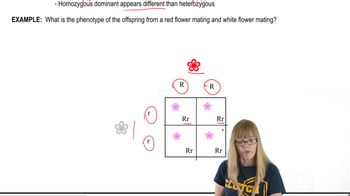Table of contents
- 1. Introduction to Genetics51m
- 2. Mendel's Laws of Inheritance3h 37m
- 3. Extensions to Mendelian Inheritance2h 41m
- 4. Genetic Mapping and Linkage2h 28m
- 5. Genetics of Bacteria and Viruses1h 21m
- 6. Chromosomal Variation1h 48m
- 7. DNA and Chromosome Structure56m
- 8. DNA Replication1h 10m
- 9. Mitosis and Meiosis1h 34m
- 10. Transcription1h 0m
- 11. Translation58m
- 12. Gene Regulation in Prokaryotes1h 19m
- 13. Gene Regulation in Eukaryotes44m
- 14. Genetic Control of Development44m
- 15. Genomes and Genomics1h 50m
- 16. Transposable Elements47m
- 17. Mutation, Repair, and Recombination1h 6m
- 18. Molecular Genetic Tools19m
- 19. Cancer Genetics29m
- 20. Quantitative Genetics1h 26m
- 21. Population Genetics50m
- 22. Evolutionary Genetics29m
3. Extensions to Mendelian Inheritance
Variations of Dominance
Problem 9b
Textbook Question
The A and B antigens in humans may be found in water-soluble form in secretions, including saliva, of some individuals (Se/Se and Se/se) but not in others (se/se). The population thus contains 'secretors' and 'nonsecretors.' Determine the proportion of various phenotypes (blood type and ability to secrete) in matings between individuals that are blood type AB and type O, both of whom are Se/se.
 Verified step by step guidance
Verified step by step guidance1
Identify the genotypes of the parents. The blood type AB individual has genotype I^A I^B for the ABO blood group and Se/se for the secretor status. The blood type O individual has genotype ii for the ABO blood group and Se/se for the secretor status.
Determine the possible genotypes of the offspring for the ABO blood group. The AB parent can pass on either I^A or I^B, while the O parent can only pass on i. Therefore, the possible genotypes for the offspring are I^A i and I^B i, corresponding to blood types A and B, respectively.
Determine the possible genotypes of the offspring for the secretor status. Both parents are Se/se, so the possible combinations for the offspring are Se/Se, Se/se, and se/se.
Combine the ABO blood group genotypes with the secretor status genotypes to determine the possible phenotypes of the offspring. For each blood type (A or B), consider the secretor status (secretor or nonsecretor).
Calculate the proportion of each phenotype by considering the probability of each genotype combination. For example, the probability of being blood type A and a secretor is the probability of being I^A i (blood type A) and either Se/Se or Se/se (secretor).
Recommended similar problem, with video answer:
 Verified Solution
Verified SolutionThis video solution was recommended by our tutors as helpful for the problem above
Video duration:
4mPlay a video:
Was this helpful?
Key Concepts
Here are the essential concepts you must grasp in order to answer the question correctly.
Blood Type Genetics
Human blood types are determined by the ABO gene, which has three alleles: A, B, and O. Blood type AB results from the presence of both A and B alleles, while type O is characterized by the absence of A and B antigens. Understanding how these alleles combine during inheritance is crucial for predicting offspring blood types.
Recommended video:
Guided course

Descriptive Genetics
Secretor Status
The ability to secrete A and B antigens in bodily fluids is determined by the Se gene. Individuals with at least one Se allele (Se/Se or Se/se) are classified as 'secretors,' while those with the se/se genotype are 'nonsecretors.' This distinction is important for understanding the phenotypic outcomes in the given genetic cross.
Recommended video:
Guided course

Repair Pathways
Punnett Square Analysis
A Punnett square is a tool used to predict the genotypic and phenotypic ratios of offspring from a genetic cross. By mapping the alleles of the parents, one can visualize the potential combinations and determine the likelihood of various traits, such as blood type and secretor status, in the offspring.
Recommended video:
Guided course

Chi Square Analysis

 4:37m
4:37mWatch next
Master Variations on Dominance with a bite sized video explanation from Kylia Goodner
Start learningRelated Videos
Related Practice


